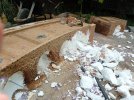Not quite sure why you were putting in gravel?Its definitely just a section where the concrete wasnt mixed properly, as I peel off the front its a lot tougher and no crumbling sections. I got someone to help me with the pour for the second section and he told me to let the dry ingredients mix for a bit before adding water. I was just bunging everything in at once and letting it mix, so its likely the short section I poured alone has lumps that arent properly mixed in.
Because I used a very fine 6mm gravel (the same one I use for ballast) the ratios were:
1-and-a-half bucket cement
2 bucket 6mm gravel
2 bucket sharp sand
2 cups 'buff' and 1 cup 'brown' cement dye powder (this produces a light brown sandstone-y shade)
The front - much nicer see:
View attachment 342904
Mixing should have been done all in one go but another way I have used is to have a central removable section so that you create the outside to be seen faces, then add a mix with gravel in the centre with possibly a few bits of rod to give strength then pull out the separating bits andcomplete the top surface mix. This the central bit could have gravel.
A mix of 1 part cement to 3 parts sharpe or even building sand including your colour option will give you nice clean detail, in the middle a mix of 1 cement 3 parts sharpe sand and possibly 2 parts gravel works nicely.


![20250614_125221[1].jpg 20250614_125221[1].jpg](https://cdn.gscalecentral.net/2025/06/thumb/542740_20250614_1252211.jpg)
![20250713_111640[1].jpg 20250713_111640[1].jpg](https://cdn.gscalecentral.net/2025/07/thumb/545438_20250713_1116401.jpg)